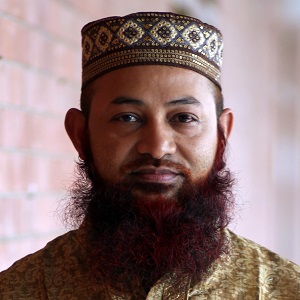
Dr Ahmed Jalal Uddin
Assistant Professor
Department of Yarn Engineering
Faculty of Textile Engineering
BANGLADESH UNIVERSITY OF TEXTILES
92 Shaheed Tajuddin Ahmed Avenue Tejgaon Industrial Area, Dhaka - 1208, Bangladesh
Education
Last Updated: 17 Sep 2024
Journal Publication
Investigation of the performance of okra fiber in woven fabric
Unusable cotton spinning mill waste: A viable source of raw material in paper making
Enhancing the quality of elastane-cotton core yarn by compact spinning
Outstanding Reinforcing Effect of Highly Oriented Chitin Whiskers in PVA Nanocomposites
Green Nanocomposites: Polyvinyl Alcohol Reinforced with Extremely Oriented Cellulose Whiskers
Fabrication of High Strength PVA/SWCNT Composite Fibers by Gel Spinning
Characterization of the Poly(vinyl alcohol)/Cellulose Whisker Gel Spun Fibers
Utilization of Green Tea Extract Dispersant for SWCNT-reinforced Polymer Composites
Extremely Oriented Tunicin Whiskers in Poly(vinyl alcohol) Nanocomposites
Crystal Modulus of a New Semiaromatic Polyamide 9-T
Enhancing Mechanical Properties of Gel-Spun Polyvinyl Alcohol Fibers by Iodine Doping
A Novel Approach to Reduce Fibrillation of PVA Fibres Using Cellulose Whiskers
Preparation and Physical Properties of Regenerated Cellulose Fibres from Sugarcane Bagasse
Fabrication of Carbon Fibers from Electrospun Poly(vinyl alcohol) Nanofibers
Melt Spinning and Laser-Heated Drawing of a New Semi-Aromatic Polyamide, PA9-T Fiber
Drawing Behavior and Characteristics of Laser Drawn Polypropylene Fibers
Last Updated: 01 Oct 2024
Books
- “Characterization of Textile Fibres”, Preview Publishers, Dhaka, 2014.
- Two chapters titled “Coating for Technical Textile Yarns” and “Novel Technical Textile Yarns” in the book, namely “Technical Textile Yarns,” edited by R. Alagirusamy and A. Das, Woodhead Publishing Ltd, Cambridge, UK, 2010.
Last Updated: 01 Oct 2024
Last Updated: 17 Sep 2024
Investigation of the performance of okra fiber in woven fabric
Unusable cotton spinning mill waste: A viable source of raw material in paper making
Enhancing the quality of elastane-cotton core yarn by compact spinning
Outstanding Reinforcing Effect of Highly Oriented Chitin Whiskers in PVA Nanocomposites
Green Nanocomposites: Polyvinyl Alcohol Reinforced with Extremely Oriented Cellulose Whiskers
Fabrication of High Strength PVA/SWCNT Composite Fibers by Gel Spinning
Characterization of the Poly(vinyl alcohol)/Cellulose Whisker Gel Spun Fibers
Utilization of Green Tea Extract Dispersant for SWCNT-reinforced Polymer Composites
Extremely Oriented Tunicin Whiskers in Poly(vinyl alcohol) Nanocomposites
Crystal Modulus of a New Semiaromatic Polyamide 9-T
Enhancing Mechanical Properties of Gel-Spun Polyvinyl Alcohol Fibers by Iodine Doping
A Novel Approach to Reduce Fibrillation of PVA Fibres Using Cellulose Whiskers
Preparation and Physical Properties of Regenerated Cellulose Fibres from Sugarcane Bagasse
Fabrication of Carbon Fibers from Electrospun Poly(vinyl alcohol) Nanofibers
Melt Spinning and Laser-Heated Drawing of a New Semi-Aromatic Polyamide, PA9-T Fiber
Drawing Behavior and Characteristics of Laser Drawn Polypropylene Fibers
Last Updated: 01 Oct 2024
Last Updated: 17 Sep 2024
- “Characterization of Textile Fibres”, Preview Publishers, Dhaka, 2014.
- Two chapters titled “Coating for Technical Textile Yarns” and “Novel Technical Textile Yarns” in the book, namely “Technical Textile Yarns,” edited by R. Alagirusamy and A. Das, Woodhead Publishing Ltd, Cambridge, UK, 2010.
Last Updated: 01 Oct 2024
Last Updated: 17 Sep 2024
Last Updated: 17 Sep 2024
Last Updated: 17 Sep 2024